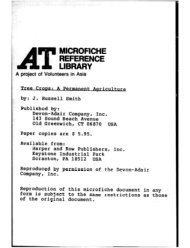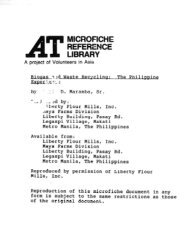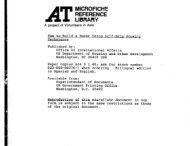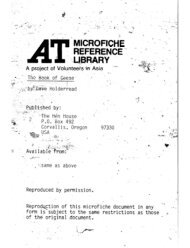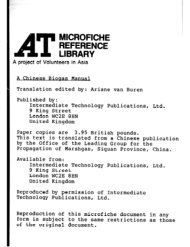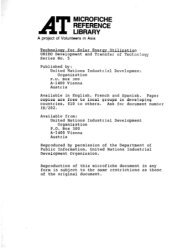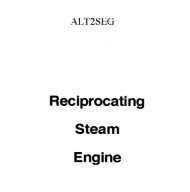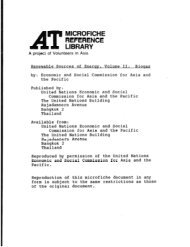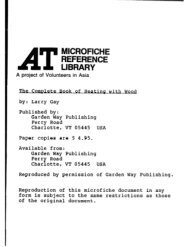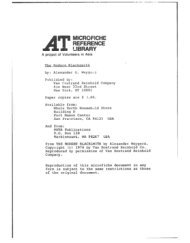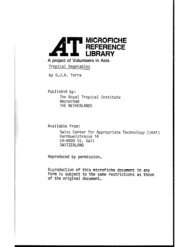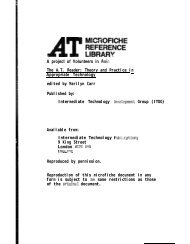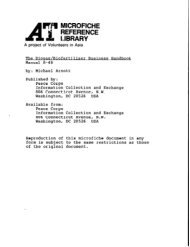Vegetation as an indicator of high wind velocity
Vegetation as an indicator of high wind velocity
Vegetation as an indicator of high wind velocity
You also want an ePaper? Increase the reach of your titles
YUMPU automatically turns print PDFs into web optimized ePapers that Google loves.
compression wood. The mech<strong>an</strong>isms that could' cause reaction,tiood include<br />
<strong>as</strong>ymmetric auxin production, g rowth inhibitors or auxin destroying enzymes.<br />
Competition will result in eccentric shaped boles if growth in<br />
one or more quadr<strong>an</strong>ts is affected by competition for light <strong>an</strong>d nutrients;<br />
Trees in open are<strong>as</strong> or thinly populated st<strong>an</strong>ds will also generally have<br />
larger circumferences for the same height th<strong>an</strong> trees in more densely<br />
populated st<strong>an</strong>ds.<br />
Among the things we have learned in our research thus far include:<br />
* Exposure <strong>of</strong> the trees to <strong>wind</strong> may vary over the life <strong>of</strong> the<br />
tree <strong>an</strong>d therefore the <strong>an</strong>alysis <strong>of</strong> indices for a domin<strong>an</strong>t<br />
tree in st<strong>an</strong>d <strong>of</strong> trees is more complex th<strong>an</strong> the <strong>an</strong>alysis<br />
for <strong>an</strong> isolated tree.<br />
* Competition for light <strong>an</strong>d food reserves h<strong>as</strong> a.strong<br />
influence on all indices but particularly on C, E,<br />
<strong>an</strong>d S. Isolated trees should be <strong>an</strong>alyzed <strong>as</strong> a separate<br />
data set from trees in a forest.<br />
* Slope seems to be <strong>an</strong> import<strong>an</strong>t factor affecting the<br />
formation <strong>of</strong> reaction wood, eccentric growth <strong>an</strong>d the<br />
relationship <strong>of</strong> height <strong>an</strong>d circumference. In future<br />
<strong>an</strong>alyses <strong>an</strong> attempt will be made to filter out this effect.<br />
* Species <strong>an</strong>d age influence the response <strong>of</strong> each index to<br />
the <strong>wind</strong>. In Ponderosa Pine, the response <strong>of</strong> the values<br />
<strong>of</strong> Eccentricity seem more sensitive to the <strong>wind</strong> speed<br />
th<strong>an</strong> the values for Dougl<strong>as</strong>-fir. Compression ratios in<br />
young trees vary more th<strong>an</strong> those <strong>of</strong> mature trees.<br />
* It appears that trees may be more responsive to the<br />
average <strong>wind</strong> speed from the prevailing direction th<strong>an</strong><br />
the average <strong>wind</strong> from all directions. If this is true,<br />
contact type <strong>wind</strong>-run <strong>an</strong>emometers may not provide<br />
sufficient information for our study.<br />
These results are promising but we will need more data <strong>an</strong>d more<br />
detailed <strong>wind</strong> information particularly from locations which have long term<br />
<strong>wind</strong> records.<br />
b. Wind Effects on Co<strong>as</strong>tal Salal<br />
The results <strong>of</strong> the research conducted thus far on <strong>wind</strong> effects<br />
on salal are inconclusive. Analysis <strong>of</strong> photographs taken over the four-<br />
month period from April - July 1977 indicated a slight incre<strong>as</strong>e in pl<strong>an</strong>t<br />
growth but almost no difference in growth between screened are<strong>as</strong> <strong>an</strong>d<br />
unscreened are<strong>as</strong> could be detected. The pl<strong>an</strong>ts behind the large screen<br />
appeared to have the largest incre<strong>as</strong>e in growth (about 3 cm>. The other<br />
-8-<br />
.’ .<br />
--=w



